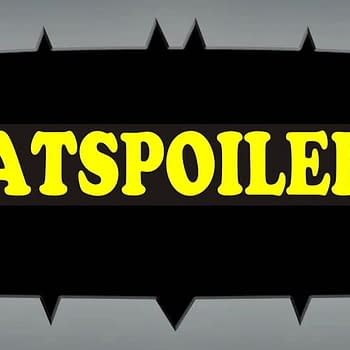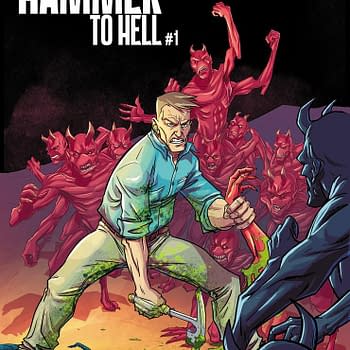Posted in: Comics | Tagged: Comics, dirk manning
How To Make A Million Dollars In Comics (Part 1 Of 2) – Dirk Manning's Write Or Wrong #76
By Dirk Manning
In case you missed the news, I have two new books in PREVIEWS this month: a double-sized flipbook from Image Comics titled Love Stories (to Die For) and the first issue of my four-issue story arc from The Legend of Oz: The Wicked West in which I get to tell the origin of the flying monkeys.
If you like this column – or just good comics – I can't encourage you enough to pick up these two comics, and you can do so by printing off this coupon and presenting it to your local comic shop:
(And keep in mind, these are comics rather than graphic novels. If you don't preorder them now, there is no guarantee you will get a chance to get your hands on them later – especially at cover price.)
That aside, let's talk about how to make money, eh?
Specifically, let's talk about how you can make one million dollars in comics.
Because it can happen.
It won't happen in a day, or a week, or a month, or even a year… but with a lot of hard work and – admittedly – a little luck, it can happen.
Truth be told, the "science" behind making a million dollars is really almost brain-numbingly simple.
In the interest of giving credit where credit's due, please allow me to explain that this is a lesson I first learned from my grandfather, who for the sake of this column I'll just call… Grandpa.
(I strongly considered placing my favorite picture of Grandpa here – the one where he's wearing dirty coveralls, chewing a twenty-five cent cigar, and holding a plastic mug of cold coffee while rocking some semi-slicked gray temples ala "Paulie Walnuts" – but I like the idea of someone out there not having pictures posted of himself/herself online, more than I do sharing the picture with all of you. Sorry. Take my word for it, though, it's a great picture… and if you need to "picture" what my grandfather looks like, well, "Paulie Walnuts" aint' too far off at all, really.)
Like many people who are lucky enough to know (or have known) their grandparents, I am especially close with mine… especially Grandpa. While I mean this with no disrespect to my mother and father, ever since my teens it's been obvious to both Grandpa and myself that I am just as much his "son" in spirit as I am his grandson by blood. Sure, the generational gap exists – and at times has proven almost unbridgeable – but even during such instances our mutual sensibilities (I say that as if I'm his equal – ha!) have been enough to allow us to converse about just about anything one way or another.
Grandpa will be the first to tell you that he was never one for school, much preferring to work and earn money rather than sit at a desk and learn. When he was sixteen, he convinced his parents to let him drop out so he could work full-time, which he did and, at over eighty years-old as I type this, he continues to do to this very day.
Grandpa comes from the "old school" in regard to finances and is one of those rare people who can – and seemingly does – see money in everything.
A "picker" (before the term even existed) and a seasoned auction attendee six decades before crappy reality TV shows made going to auctions hip, Grandpa was one of those (what we'd now call) "old-timers" who built his own success from the ground up, nickel by nickel, eventually amassing all those nickels into enough money so that he could launch his own business – a business that now been in our family for three generations and counting.
(Obviously I didn't get in on that action. Had I been more traditionally business-minded in that regard most of you would have never known me as "Dirk Manning: Comic Writer and Columnist" and, instead, only a few of you (at best) would have known me as "Dirk Manning: Store Manager.")
When I was in my early teens I started to spend several days a week every summer working odd jobs with Grandpa. By the time I was a teenager he had handed the day-to-day operations of his main business to my parents, and spent his days at his side business where he sold miscellaneous items like trailers, burn barrels, chickens, rabbits, and other various odds and ends.
If the idea of someone selling things like trailers, chickens, and burn barrels as part of a profitable side-business for sounds a bit odd to you, keep in mind that I grew up in semi-rural Ohio… and no, that's not a redundant statement, thank you very much.
Oh… Grandpa also sold buckets.
Plain ol' five gallon white buckets.
Lots and lots of buckets.
Grandpa would buy the buckets from local and regional factories that produced things like chicken and ice cream delicacies (I'd like to think they were two separate locations, but I never did ask and, even now, am afraid to do so) who were all too happy to sell this seemingly crazy old Pollack the buckets by the truckload for about a quarter a piece.
Why, you ask?
Well, when these buckets came to Grandpa they were pretty cruddy, with the insides still lined with the residue of either fudge, caramel, or chicken guts, respectively.
You see, the factory workers would empty out the buckets and then toss them aside without washing them out, and the dirty buckets would then be shipped off to Grandpa, who gladly bought them for a quarter a piece, sometimes a semi-truckload at a time.
Nonplussed by the foul – and sometimes fowl – odors, Grandpa and I would unload the buckets and, as per Grandpa's specific instructions, line them up all over his property open-side up. We'd then hose them out a bit and then leave them out in the elements to, as Grandpa put it, "let nature do its work" on them…
And sure enough, after a few days the combination of sun and hose water (or, if we were lucky, rain) would do enough so that the buckets could then be cleaned out and stored with minimal effort… and, thankfully, minimal stench.
(Because let me tell you, I've yet to ever smell anything as pungent or repugnant as the smell of raw chicken guts that have been sitting in the back of a factory warehouse truck for at least a week. I assure you, you can't possibly imagine it. You'd just have to experience it. Not that you'd ever want to… I hope.)
If everyone thought Grandpa was a little crazy for buying and stockpiling hundreds upon hundreds of these five gallon white buckets (SPOILER ALERT: they did), they though he had completely gone off his rocker when he went as far as to build a massive multi-compartmental pole-barn to store them all in…
And, honestly, I was among those who thought that, in his bucket-buying frenzy, he had somehow become so enamored with the notion that he could buy five gallon buckets for a quarter a piece that he had forgotten to stop and ask himself if he should.
So, being the respectful young man that I was – and also being a bit concerned as to whether or not he needed some sort of bucket intervention – I asked him about it.
"Grandpa," I said on one particularly hot day we were spending shoveling stone into a subbasement that needed leveling out. "Why are you stockpiling all these buckets? You must have at least a thousand of them in there."
"Oh, I got more than a thousand," he replied, smirking. "Or at least I will by the time I'm done."
"OK…" I said carefully. "But, seriously, why so many? Do you really think you're going to sell that many?"
"I'll sell 'em all eventually," he replied, never breaking his pace as he shoveled massive scoop after massive scoop of stone into the trench we were filling. "Not overnight, mind you, but I will, and when all's said and done I hope to sell enough of 'em that I can use that money to make a million dollars."
He then went on to explain to me how he was the only guy in the region who had these non-descript, five-gallon buckets (keep in mind, this was decades before large cookie-cutter home supply stores such as Home Depot and the like existed), and that if anyone wanted one, they'd have to come to him to get him.
In short, Grandpa's plan was to make himself "The Bucket King" of the region. If you
wanted a five gallon bucket, you'd have to go to him and pay the not-so-whopping sum of $1.25 to get one.
He was grinning the whole time he told me this, most likely due in no small part to how poorly I was hiding my confusion.
Truthfully, at this point I was sure that a heat stroke had fried his brain or something. Did he really think – even over the course of five or ten years – that he was going to make a million dollars selling white five-gallon buckets?
As I pondered this, he continued on, teaching me the lesson I'm about to share with all of you.
"It's easy to make a million dollars," he said. "All you have to do is buy a million hats for a dollar each and sell each one for two dollars. You do that and you've just made a million dollars in profit."
I replied to him with the same line that I suspect a lot of you are thinking to yourselves right now: "Yeah, but I don't have a million dollars!"
Again, without missing a beat (or a shovel-load) he replied. "Do you have $20?"
"Yeah," I replied, not sure where he was going with this, as there's a large gap between twenty and a million.
"If when you're getting started you only have twenty dollars, you start with twenty hats. Then you sell 'em all, and then you have forty dollars." He was still smirking and shoveling away, of course, as the light bulb of illumination went off over my head. "You know what to do then, right?
"Then I take my forty dollars and buy forty hats…" I muttered in a Zen-like moment of enlightenment.
"Exactly." Grandpa beamed. "Hats, chickens, trailers… buckets. Whatever it is you can sell. You may have to change it up a bit as you go, though, and it won't happen overnight, but you keep at it with that approach then over a lifetime – and hopefully even sooner – you'll make a million dollars and be a millionaire. Then you can pay someone else to help you shovel your stone." He said, burying the blade of his shovel up to the wooden handle in one strong thrust and tossing me a wink. "Now c'mon, let's take a break and get some iced tea."
As you can probably imagine, it was one of the best glasses of iced tea I'd ever had – or will ever have – in my life.
After all, I had just learned just how easy it was – and is – to make a million dollars.
I realize that some of you may criticize this approach as being overly simplistic, but it's really not – even in regard to making – and making money in – comics.
It won't happen overnight, though, and it will take some serious dedication and investments on your part.
As I've discussed in this very column (and the book collection Write or Wrong: A Writer's Guide to Creating Comics – which is now available both in print and on the Kindle via Amazon by clicking right here and is something you should own – or own soon – if you're genuinely serious about creating comics), there are a lot of financial costs that come with doing things like printing your own comics and hitting the comic convention circuit to promote your book(s).
You see, as is the case with any business, you're going to have to spend (read: "invest") some money early to make some money later.
As I discussed in the last column (Write or Wrong #75: "You Will Live the Dream"), I, like many up-and-coming creators, spent (again, read: "invested") my fair share of money attending shows where I had no chance of coming out ahead financially… but over time as I became more of a "known quantity" at the shows and increased the amount of product (read: books) I had available, I was able to start breaking even and even eventually starting coming out ahead at the end of most shows I attended.
It will take a financial investment on your part, though, as well as patience and some keen business savvy… savvy?
We'll get into the cost of doing conventions – and how over time you can start to recoup the early losses you're guaranteed to experience on the convention circuit – in the second half of this column… but before we get to that, we first need to talk about what you'll need to make (and invest) your money…
And that, of course, is comics.
Actual, printed, physical copies of your comics.
When it comes to self-publishing your comics, there's two main ways to go about it: Print-on-Demand vs Off-set Printing.
Both have their pros and cons (no pun intended), and the approach that's right for you really depends on a realistic assessment of where you are in your career, how much money you have to invest, how many outlets you have to sell books, how many comic conventions you'll be attending per year, and how many books you can honestly sell over the course of a year's worth of conventions.
So… that being said, let's do some simple and honest number-crunching for a moment, shall we?
After all, you do want to make a million dollars, right?
[DISCLAIMER: Printing costs tend to fluxuate a bit one way or another depending on a lot of outside factors, the least of which not being paper costs. The prices below are based on those accessed in July 2013. Should you be reading column at a much later date you may find the prices slightly different… but this should give you a pretty solid ballpark idea of the finances involved in printing your own comics… unless, you know, there's a global meltdown or something.]
PRINT-ON-DEMAND
If you go the Print-On-Demand (henceforth referred to as "POD") route through someone like Ka-Blam you can do very small print-runs, even ordering merely one single copy of your comic at a time if you so choose. More realistically, though, if you're going to a convention and take, say, 40 books with you, you can use a POD printer to print 40 books and then wait to sell through them all before ordering any more. When that happens (whether it be at your first show or at your fifth), you can then print 40 more comics (or whatever amount you want) for your next convention/signing appearance, all without having to invest a huge lump of money upfront nor without having to (possibly literally) sit on a huge backstock of books for months or years on end.
That's the major advantage of using POD.
The biggest disadvantage of using a POD printer, though, is that they usually don't offer a bulk discount. Specifically, it doesn't matter if you print 1 book or 1,000 books – the price is the price is the price. As such, POD comics also tend to be a bit more expensive per unit than using an off-set printer (which we'll get to more in a moment).
For example, if you were to use Ka-Blam to print a 24-page full color book with a Ka-Blam ad on the back cover you're looking at a cost per issue of $2.70, not including shipping (which would of course depend on the amount of books you were having shipped to you, with more books being more expensive to ship).
Shipping aside, if you opt to go with black and white interior pages a 24-page comic would cost you $1.65 per issue.
Using these numbers (and factoring in shipping which, of course, gets more and more expensive as you look to shipping more and more books at a time), this means that even if you're going to print and sell 1,000 books over the course of a year (which, honestly, you most likely won't – especially up front) you're looking at investing between $1,645 (for black and white comics) and $2,695 (for full color comics) in print costs alone.
If you're going the POD route, though, you won't be ordering 1,000 books at a time (if you're going to do that, you should instead consider using an Off-set printer), and instead will most likely be investing a hundred dollars or so at a time, ordering books on a "per convention" (rather than a "per year") basis.
Printing costs (and amounts) aside, the other factor to consider is the cover price you're going to set for your comic. On a show floor most people won't spend more than $3 for a black and white "indie comic" from a creator they're not familiar with (read: YOU), with a $5 limit usually being the highest amount they'll pay for a full-color comic under the same set of circumstances.
Considering this, let's say you want to play it conservative and charge $3 a book – just in hopes of moving more books on via "impulse" and "curiosity" buys.
Going the POD route, this means your profit per full color book (not even taking shipping into account) will be 30 cents per color comic sold or $1.35 per black and white comic sold.
If, over the course of a year, you were to sell 1,000 POD comics you'd make $300 profit on the color books you invested $2,695 to print or $1,350 profit on the black and white books you spent $1,645 to print.
Of course, the real kicker here is that you won't sell 1,000 books over the course of a year – especially during your first year on the convention circuit.
If you have an amazing sense of salesmanship you might sell 500 books over the course of your first year, meaning if you sell 500 copies of your black and white 24-page comic for $3 a pop, you will spend $822.50 (not including shipping) to make $675 dollars in profit…
But that "profit" doesn't consider the amount of money you'll have spent over the course of that same year on Artist Alley tables as well as the food, hotel, and travel expenses all associated with participating in the comic convention circuit where you will be selling your books.
Let that all sink in for a moment, folks.
Specifically, let it sink in to the point where you realize that you will most likely be losing money in the long run when you try to hit the convention circuit selling POD comics at reasonable prices.
(Admittedly, you could try to sell your 24-page black and white comics for $5 each, meaning you'd be making a profit of $3.65 per issue – which is some "real money" in terms of your cost to profit ratio… but I'd argue that by having a higher price point like that you'll sell less books… and as such your numbers will even out to around the same way anyway. For most of you, at least.)
(Conversely, you could sell invest $2.70 per issue into printing 24-page full color books and sell them for $5 each, making $2.30 per book. At this price point, were you to somehow sell 500 books over the course of a year – ordering them in small print runs per show, of course – you'd make $230 in profit… which would barely cover the cost of one Artist Alley table at a mid-sized show, let alone the other four tables you'd need to spend money on at the four other shows to sell 500 books your first year out to begin with.)
Now, all of that being said, let me make one thing about POD printing perfectly clear:
I am a HUGE proponent of using POD to publish your comics when you're just getting started… even on the convention scene.
Yes, even though by using POD you'll most likely be "losing" money up front.
You'll notice that I put the term "losing" in quotes just now, and the reason is because, by going the POD route, you're not really "losing" money as much as you're "investing" money in your career as a comic book professional.
When it comes to any career in "the arts" (be it music, painting, sculpture, comics, etc.) you're going to have to put in a considerable amount of effort and finances in order to just have the chance to make money doing what it is you love in the long run.
More specifically, as I've said numerous times over the lifespan of this column (including, most recently, in this very installment of this column), you're going to have to spend money to make money, and if you're serious about being in the comics game for the long haul, hitting shows with short runs of your book that you've published via a POD printer is the way to minimize your investments and space out your losses/investments a bit more than printing your books through an off-set printer will allow you to do.
Speaking of off-set printing…
OFF-SET PRINTING
If you go the off-set Printing route through someone like PrintNinja you will need to print a minimum of 500 books up front to make it as cost-effective as possible.
Lest you think to yourself "Five hundred books? That's no big deal! I can move five hundred books in a year on the convention circuit, through the local comic shop and my friends!" let me again remind you of the importance of being honest and realistic with your expectations.
Five hundred books is a lot of books – especially when you're not going to be selling them in bulk to comic shops across the country due to Diamond's minimum order standards policy which – most likely – you won't be able to meet during your first few years of self-publishing comics, and especially without the "clout" even a small publisher will give you.
If you're a visual thinker, think of it this way: Your average comic longbox holds about 200 unboarded comics… meaning if you were to print "only" 500 copies of your comic that you'd have to "hand-sell" – one by one – about two and a half longboxes of that same single issue of your comic in order to sell them all.
Longboxes are almost impossible to lug back and forth to shows, though… so if we're talking short boxes (which hold around 150 comics each) you're looking at three short boxes (and change) worth of the same issue of your self-published indie comic.
Obviously those numbers should be doubled if you choose to print 1,000 copies of your book. In this scenario, imagine, if you can, storing five longboxes – or about seven short boxes – worth of duplicates of the same comic in your bedroom or home office. That's off-set printing, folks.
Mind you, I'm not saying it's impossible to sell that many books – because it's not. It's just very unlikely that you'll sell that many on your first go-around on the convention circuit.
However, the upside is that by going through an off-set printer, you can get a much better cost per unit. The aforementioned PaperNinja, for example, advertizes that you can get 1,000 full-color, 28-page comics printed for $1 per issue (not including shipping, which may push you slightly over that amount).
That's a helluva deal, but practically speaking it means you'll be investing over $1,000 to start sitting on 1,000 copies of the same issue of the same comic when you get your shipment.
The other option with off-set printing is to order only 500 copies of your comic ("only" 500 copies – ha!). However, in doing so you'd only be saving about $146 on your printing costs, which leads to an interesting dilemma: Do you want to save the $146 dollars to invest in other places, or go "whole hog" and spend the extra $200 ($146 for printing, plus an additional $50 for shipping) to double your amount of stock? When we're talking about figures around $1,000, it's easy to say "Go big or go home, hoss!", but keep in mind that $200 is more than just a number on a screen, and that when you're ordering 1,000 copies of a single comic that storage space and consumer fatigue can become major obstacles. (Do you really want to be shilling the same lone comic on the convention circuit year after year after year without having new installments of it to offer?)
Your opinions on whether to order 1,000 vs 500 copies will vary, but either way, keep in mind that in either quantity, this is a lot of books to have on hand, and when you're just getting started you're never going to sell as many books as you think you should.
Using the same specs I did a few minutes ago when discussing POD publishers, let's say that you're going to go full-tilt and print 1,000 copies of your full-color, 24-page book. When you use an off-set printer such as this one it doesn't really matter if your book is in black and white or in color, so, if you're dead-set on printing color comics, that's a big perk in using off-set printing companies such as this one.
(Going with black and white interiors on 1,000 books over at PrintNinja, for example, would only save you around $40… and when you're looking to invest around $1,000, the $40 difference to have your books in color should be a no-brainer, in my opinion, if for no other reason that you can have a higher cover-price on a full-color book than you can on a black and white one.)
(Similarly, in this case you can actually have your whole print-run of 1,000 comics be 28 pages each (rather than 24 pages each) for a mere $12 more on your total printing costs… so there's another little "bonus" to consider as well. For the sake of keeping things "even," though, we'll operate under the assumption that you're printing 1,000 copies of a 24-page comic.)
Using an off-set printer, 1,000 copies of your 24-page full color comic would cost you $943.80 plus about another $100 for shipping from China, making your cost per unit about $1.04 per book.
Were you to sell the books at conventions, etc. for $3 each, you'd be looking at a profit of $1.96 per book, hence making you an even better profit than that advice Grandpa (remember him?) gave when he said the best way to make a million dollars is to buy a million hats for $1 each and sell each one for $2…
Except, you know, we're talking about comics, not hats. Of course.
Don't get too excited, though.
After all, making $1.96 profit per book, you'd need to sell 533 books just to cover your printing costs alone, and as I discussed earlier, that's a lot of books to "hand-sell" in a year… and even then, you still have to pay for your table space at conventions, hotel rooms, food, and travel expenses.
The upside here, though, is that you could fiddle with the numbers a bit and maybe offer your potential patrons a 28-page full color book for a $5 cover price (which is pretty fair for a 28-page full color book from an "indie-creator" such as yourself), hence bumping your profit per issue up to around $3.93 per unit sold, meaning you'd only (there's that "o" word again – be wary of it!) have to sell around 272 copies of your comic to cover the printing costs… which, while still difficult, is at least in the realm of possibility if you have a good-looking comic that resonates well with passersby on the convention floors.
(If you want to shoot for the middle and sell your 28-page full comic for $4 an issue, which is comparable to what even some Image Comics titles cost, you'd "only" have to sell 365 copies of your comic… the equivalent of one comic a day, every day, without fail, for a whole year, to cover the printing costs alone.)
All of that being said, though, I'd be remiss if I didn't point out that, in regard to off-set printing, were you to go the more conservative route and order 500 copies of a 24-page full color comic, you're looking at a grand total of around $836.75 for printing and shipping costs. Were you to have a $5 cover price on your book, you'd need to sell a mere 168 copies of your comic to cover your printing costs, which, obviously, is easier than printing 1,000 books and have to sell 272 copies of them.
Food for thought.
Again, keep in mind that I'm only talking about covering your printing costs, here.
Not Artist Alley table costs.
Not food costs.
Not hotel costs.
Not travel expenses.
And certainly not any spending money you may want to have with you at the conventions.
Now… lest you think that the situation is totally bleak and dire in terms of making money – and that it's total impossible to make a million dollars in comics – rest assured, it's not.
As Grandpa himself wisely said, it's not going to happen overnight… or even in a year.
It can happen, though, if you're willing to dedicate yourself to making your career in comics a marathon rather than a sprint.
Because make no mistake, printing costs aside, you're still going to have to spend some serious money if you want to make money.
In the part two of this column (because, let's admit it, I've given you a lot of information to digest already) we'll pick up right here where we're leaving off and talk about the "long game" approach, and how losing (investing) money up is a necessary gamble to take if you want to attempt to make money – and maybe even eventually a million dollars – in comics.
NEXT WEEK: The cold, hard numbers involved in spending money to make money in comics…
Dirk Manning is the writer/creator of the Nightmare World trilogy of graphic novels and the upcoming Love Stories (To Die For) one-shot flip-book (from Image Comics/Shadowline – all available to order from your local comic shop) and Write or Wrong: A Writer's Guide to Creating Comics (from Transfuzion Publishing – available exclusively through Amazon.com either in-print of via Kindle). Along with all of that, Dirk has also written comics for Zenescope, Activate Comix, and Big Dog Ink as well as several short films for BlackBox TV. Dirk lives on the Internet and can usually be found lurking around Facebook and Twitter on a fairly regular basis… when he's not busy writing, of course. Feel free to follow him at one or all such locations if you're into that sort of thing. Cthulhu is his homeboy.













